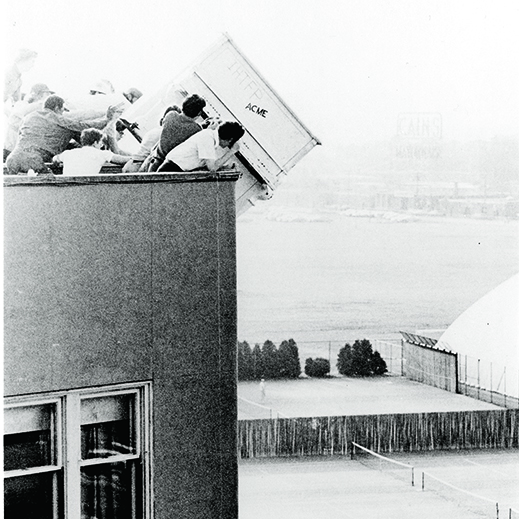In the fall of 1972, Alvin “Todd” Moser ’75 hit on the perfect subject for his final project for Doc Edgerton’s 6.714 Strobe Photography Lab. A large contingent of fellow Baker House residents was plotting to throw a piano off the roof of the dorm, onto Amherst Alley. “I thought it would be really cool to film it in slow motion,” says Moser. “It would fall down very gradually, and you would see every little thing pop off of it when it hit.”

The ringleader of this clandestine operation, Charlie Bruno ’74, had “often expressed the dream of dropping a piano off the roof,” Moser recalls. Bruno, a self-described “high school wimp turned hacker,” was legendary for his antics—streaking, water fights, kicking in the dorm elevator’s door (and then carrying dorm mates’ things up the stairs during repairs to make amends). “He came to MIT pretty much as a total introvert and somehow blossomed into the most amazing extrovert I ever saw,” Moser recalls.
The chance came when Jon Kass ’74 decided to leave Baker and offered Bruno his upright piano. The drop became “almost a house-wide project,” according to a Tech article written just after the event, and took about four weeks to plan. “Being engineers, everybody got involved and made a regular project out of the whole thing,” says Moser. Aside from the allure of wanton destruction, it provided an engineering challenge and an opportunity to conduct experiments. “It’s going to be a 6.08 problem set done in experimental form,” explained a student on a tape recording made just before the drop. Another student’s rationale: “To prove that there’s gravity.”
On the appointed day, October 24, a group of students took the piano to the sixth floor in the elevator, lugged it up the stairs to the roof, and adorned it with graffiti (including “IHTFP” and “Danger: Falling Objects”). Others were on crowd-control duty as spectators gathered below.
The crowd, unfortunately, attracted the attention of a campus patrolman, who expressed concern that “piano dropping didn’t fall in the category of Normal Student Activities,” according to the Tech. “People were yelling at me through the door to hurry up,” says Moser, who’d gone into Baker’s third-floor darkroom to load film into the high-speed camera. Now that word was out, Bruno called campus police to ask for approval. Meanwhile, Moser raced downstairs to set up the camera on a cart in Amherst Alley. Rather than waiting for the okay from police, students tossed the piano as soon as Moser was ready. But when Moser turned the camera on, nothing happened. He’d forgotten to plug it into the cart’s power strip. “It was probably the most embarrassing thing that’s happened to me in some 40 years of engineering practice,” he says.
Despite Moser’s mishap, the event was a success, drawing coverage from the Associated Press and local TV stations—and no one got in trouble. Students did take several measurements, too. Though Bruno died in 2001, his name lives on in the unit of measure they created, defined in the 1973 Technique as “the volume of a hole produced by a 600 pound piano falling 75 feet onto a concrete and asphalt pavement. 1 Bruno =.00075 cubic Smoots.”
The following spring, Baker House residents tossed a grand piano, and a few students taking 6.714 had better luck with the high-speed camera. “We got it, but it was a little out of focus,” says Elliott Borden ’73. Borden also took the first known color photos of the event, which he recently donated to the MIT Museum.
By 1975, the piano drop was an annual tradition, more or less: for the first time that year, How To Get Around MIT included the Bruno in the MIT lexicon. When Amherst Alley was moved farther away from Baker House in 1984, the drop was relocated to the Charles River side of the building. Though it was discontinued after 1998 because of safety concerns, Baker House residents resurrected it in 2005, tossing an abandoned piano that was beyond repair. They went to great lengths to avert any danger; among other things, they designed a piano launcher with a hinged ramp and a quick-release mechanism. The event was timed to coincide with spring Drop Date—the last day to drop a class—and the tradition has continued every year since.
Deborah Douglas, the director of collections at the MIT Museum, says she isn’t surprised that the piano drop has endured. “It fits the zeitgeist and culture of MIT,” she says. As Charlie Bruno summed it up in the 1974 Technique: “Good, clean destruction.”
Keep Reading
Most Popular
Large language models can do jaw-dropping things. But nobody knows exactly why.
And that's a problem. Figuring it out is one of the biggest scientific puzzles of our time and a crucial step towards controlling more powerful future models.
The problem with plug-in hybrids? Their drivers.
Plug-in hybrids are often sold as a transition to EVs, but new data from Europe shows we’re still underestimating the emissions they produce.
Google DeepMind’s new generative model makes Super Mario–like games from scratch
Genie learns how to control games by watching hours and hours of video. It could help train next-gen robots too.
How scientists traced a mysterious covid case back to six toilets
When wastewater surveillance turns into a hunt for a single infected individual, the ethics get tricky.
Stay connected
Get the latest updates from
MIT Technology Review
Discover special offers, top stories, upcoming events, and more.